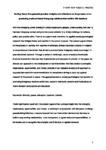Putting theory into peaceful practice: insights and reflections on the process of co-producing a school-based intergroup relations intervention with teachers
| dc.contributor.author | McKeown, S | |
| dc.contributor.author | Sagherian-Dickey, T | |
| dc.contributor.author | Kwong, J | |
| dc.contributor.author | Charlesford, JJ | |
| dc.date.accessioned | 2022-03-29T14:25:59Z | |
| dc.date.issued | 2022-05-22 | |
| dc.identifier.issn | 1078-1919 | |
| dc.identifier.issn | 1532-7949 | |
| dc.identifier.uri | http://hdl.handle.net/10026.1/18980 | |
| dc.description.abstract |
With the increasing ethnic diversity in school classrooms globally, understanding how best to harness intergroup contact and promote social cohesion is a timely challenge for science, policy, and practice alike. There is an urgent need, therefore, for applied social psychological research that bridges theory and practice in the pursuit of peace. The present article reflects on the process of working with teachers in ethnically diverse secondary schools in England to coproduce an intervention that aimed to promote better intergroup relations among 11-year-old school students. Through a series of workshops, we cocreated a theoretically informed intervention that was then implemented and evaluated in schools. In this article, we discuss our approach to the development of our intervention. We then conduct a strengths, weaknesses, opportunities, and threats analysis of our research process and approach to coproduction and offer recommendations for researchers aiming to carry out applied research in the pursuit of peace. The appropriateness of social psychological frameworks for promoting intergroup relations, and in turn, peace in real-world contexts and implications for future research and practice are discussed. | |
| dc.format.extent | 292-301 | |
| dc.language | en | |
| dc.language.iso | en | |
| dc.publisher | American Psychological Association (APA) | |
| dc.subject | Mental Health | |
| dc.title | Putting theory into peaceful practice: insights and reflections on the process of co-producing a school-based intergroup relations intervention with teachers | |
| dc.type | journal-article | |
| dc.type | Journal Article | |
| plymouth.issue | 3 | |
| plymouth.volume | 28 | |
| plymouth.publication-status | Published online | |
| plymouth.journal | Peace and Conflict: Journal of Peace Psychology. | |
| dc.identifier.doi | 10.1037/pac0000598 | |
| plymouth.organisational-group | /Plymouth | |
| plymouth.organisational-group | /Plymouth/Faculty of Health | |
| plymouth.organisational-group | /Plymouth/Faculty of Health/School of Psychology | |
| plymouth.organisational-group | /Plymouth/REF 2021 Researchers by UoA | |
| plymouth.organisational-group | /Plymouth/REF 2021 Researchers by UoA/UoA04 Psychology, Psychiatry and Neuroscience | |
| plymouth.organisational-group | /Plymouth/Users by role | |
| plymouth.organisational-group | /Plymouth/Users by role/Academics | |
| dcterms.dateAccepted | 2022-01-06 | |
| dc.rights.embargodate | 2023-5-22 | |
| dc.identifier.eissn | 1532-7949 | |
| rioxxterms.versionofrecord | 10.1037/pac0000598 | |
| rioxxterms.licenseref.uri | http://www.rioxx.net/licenses/all-rights-reserved | |
| rioxxterms.type | Journal Article/Review |


